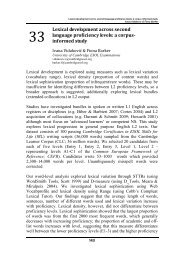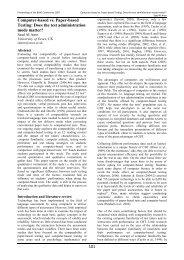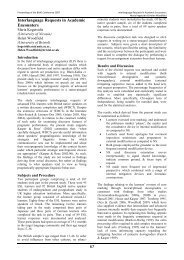The actuality adverbs in fact, actually, really and indeed - British ...
The actuality adverbs in fact, actually, really and indeed - British ...
The actuality adverbs in fact, actually, really and indeed - British ...
You also want an ePaper? Increase the reach of your titles
YUMPU automatically turns print PDFs into web optimized ePapers that Google loves.
Proceed<strong>in</strong>gs of the BAAL Conference 2007 <strong>The</strong> <strong>actuality</strong> <strong>adverbs</strong> <strong>in</strong> <strong>fact</strong>, <strong>actually</strong>, <strong>really</strong> <strong>and</strong> <strong>in</strong>deed- establish<strong>in</strong>g similarities <strong>and</strong> differences<br />
Kar<strong>in</strong> Aijmer<br />
We end up with a complex picture of how the <strong>adverbs</strong><br />
can be characterised with regard to text type <strong>and</strong> what<br />
their function is <strong>in</strong> different text type. For example,<br />
<strong>actually</strong> <strong>and</strong> <strong>really</strong> have <strong>in</strong> common that they are<br />
frequent <strong>in</strong> <strong>in</strong>teractional text types with a typical<br />
polite function. On the other h<strong>and</strong>, <strong>actually</strong> <strong>and</strong> <strong>in</strong> <strong>fact</strong><br />
(but not <strong>really</strong>) are frequent <strong>in</strong> demonstrations but not<br />
necessarily with the same function. In <strong>fact</strong> conveys<br />
the mean<strong>in</strong>g of novelty <strong>in</strong> addition to other mean<strong>in</strong>gs<br />
such as <strong>fact</strong>ual evidence. Actually seems to be more<br />
closely l<strong>in</strong>ked with the adversative function to refute<br />
an earlier statement. In cross-exam<strong>in</strong>ations on the<br />
other h<strong>and</strong> <strong>in</strong> <strong>fact</strong> had the functions of rhetorical<br />
strengthen<strong>in</strong>g or elaborat<strong>in</strong>g (mak<strong>in</strong>g someth<strong>in</strong>g more<br />
precise, summarize) with the implicature request for<br />
confirmation. Indeed on the other h<strong>and</strong> was typically<br />
<strong>in</strong> parliamentary debates with the mean<strong>in</strong>g rhetorical<br />
strengthen<strong>in</strong>g.<br />
Conclusion<br />
Modal <strong>adverbs</strong> are notoriously difficult to study<br />
because their mean<strong>in</strong>gs vary depend<strong>in</strong>g on both the<br />
immediate syntactic context <strong>and</strong> the social context. It<br />
follows that they occur <strong>in</strong> many different lexical fields.<br />
For example <strong>in</strong> <strong>fact</strong> occurs together with lexical items<br />
such as what’s more <strong>and</strong> <strong>in</strong>deed (Schwenter <strong>and</strong><br />
Traugott 2000) <strong>in</strong> some of its uses but it can also have<br />
the same mean<strong>in</strong>gs as <strong>actually</strong>. Such observations cam<br />
be strengthened by consider<strong>in</strong>g how their mean<strong>in</strong>gs are<br />
„mirrored‟ <strong>in</strong> the translations <strong>in</strong>to a target text.<br />
<strong>The</strong> contrastive or translation method has the effect to<br />
sharpen the description of the polysemy or<br />
multifunctionality of the <strong>adverbs</strong> <strong>and</strong> to show how they<br />
are related to each other <strong>in</strong> terms of shared or different<br />
mean<strong>in</strong>gs. <strong>The</strong> <strong>adverbs</strong> can be analyzed <strong>in</strong> terms of<br />
how they divide up the semantic space consist<strong>in</strong>g of<br />
mean<strong>in</strong>gs such as novel <strong>and</strong> surpris<strong>in</strong>g <strong>in</strong>formation,<br />
<strong>actuality</strong>, adversative mean<strong>in</strong>g, strengthen<strong>in</strong>g of<br />
argumentation.<br />
<strong>The</strong> functions of the <strong>adverbs</strong> can be further<br />
characterized with regard to frequency <strong>in</strong> different text<br />
types <strong>in</strong> speech <strong>and</strong> <strong>in</strong> writ<strong>in</strong>g. By tak<strong>in</strong>g <strong>in</strong>to account<br />
text type for example if the adverb is used <strong>in</strong> a<br />
demonstration or debate or <strong>in</strong>formal conversation we<br />
can throw light on the correlation between function <strong>and</strong><br />
social activity.<br />
Appendix 1<br />
Table 1: Translations of <strong>actually</strong> <strong>in</strong>to Swedish<br />
faktiskt (<strong>in</strong> <strong>fact</strong>) 35<br />
egentligen (<strong>in</strong> actual <strong>fact</strong>) 8<br />
i själva verket (<strong>in</strong> actual <strong>fact</strong>) 13<br />
verkligen (<strong>really</strong>) 8<br />
rent av (practically) 4<br />
åtm<strong>in</strong>stone (at least) 3<br />
till och med (what‟s more) 2<br />
förresten (by the way) 1<br />
på riktigt (for real) 1<br />
i verkligheten (<strong>in</strong> reality) 1<br />
118<br />
i praktiken (<strong>in</strong> practice( 2<br />
i realiteten (<strong>in</strong> reality) 1<br />
över huvud taget (at all) 1<br />
other 4<br />
ø 35<br />
total 119<br />
Table 2: Translations of <strong>in</strong> <strong>fact</strong> <strong>in</strong>to Swedish<br />
faktiskt (<strong>in</strong> <strong>fact</strong>) 24<br />
i själva verket (<strong>in</strong> actual <strong>fact</strong>) 14<br />
faktum är (<strong>fact</strong> is) 10<br />
verkligen (<strong>really</strong>) 3<br />
till och med (even) 2<br />
nämligen (the reason is that) 2<br />
i verkligheten (<strong>in</strong> reality) 1<br />
de <strong>fact</strong>o 1<br />
rent av (practically) 1<br />
väl (surely) 1<br />
förstås (of course) 1<br />
nog <strong>in</strong>te utan (probably) 1<br />
egentligen (<strong>in</strong> actual <strong>fact</strong>) 1<br />
ø 13<br />
total 75<br />
Table 3: Swedish translations of <strong>really</strong><br />
verkligen („<strong>really</strong>‟) 47<br />
riktigt („<strong>really</strong>‟) 16<br />
verkligt 4<br />
egentligen („<strong>actually</strong>‟) 45<br />
faktiskt („<strong>in</strong> <strong>fact</strong>‟) 19<br />
i själva verket („as a matter of <strong>fact</strong>‟) 2<br />
särskilt mycket („very much‟) 2<br />
ändå („anyhow‟) 1<br />
mycket („much‟) 1<br />
i grund och botten („basically‟) 1<br />
är det säkert („is it certa<strong>in</strong>‟) 1<br />
är det sant („is it true‟) 1<br />
alldeles („quite‟) 1<br />
banne mig („<strong>in</strong> truth‟ 1<br />
allt („<strong>in</strong>deed‟) 1<br />
i praktiken („<strong>in</strong> practice‟) 1<br />
på allvar („seriously‟ 1<br />
direkt („directly‟) 1<br />
alls („at all‟) 1<br />
en riktig („a veritable‟) 1<br />
förstås („of course‟) 1<br />
i sann<strong>in</strong>g („<strong>in</strong> truth‟) 1<br />
men („but‟) 1<br />
bara (<strong>in</strong>te) („only not‟) 1<br />
på hedersord („on my word of honour‟) 1<br />
ø 135<br />
Table 4: Translations of <strong>in</strong>deed <strong>in</strong>to Swedish<br />
verkligen („<strong>really</strong>‟) 20<br />
faktiskt („<strong>in</strong> <strong>fact</strong>‟) 19<br />
i själva verket („as a matter of <strong>fact</strong>‟) 10<br />
rentav („practically‟) 4<br />
(ja) m<strong>in</strong>sann („yes‟), jajamänsan 3<br />
mycket riktigt („very much the case‟) 3<br />
och naturligtvis („<strong>and</strong> of course‟) 3







